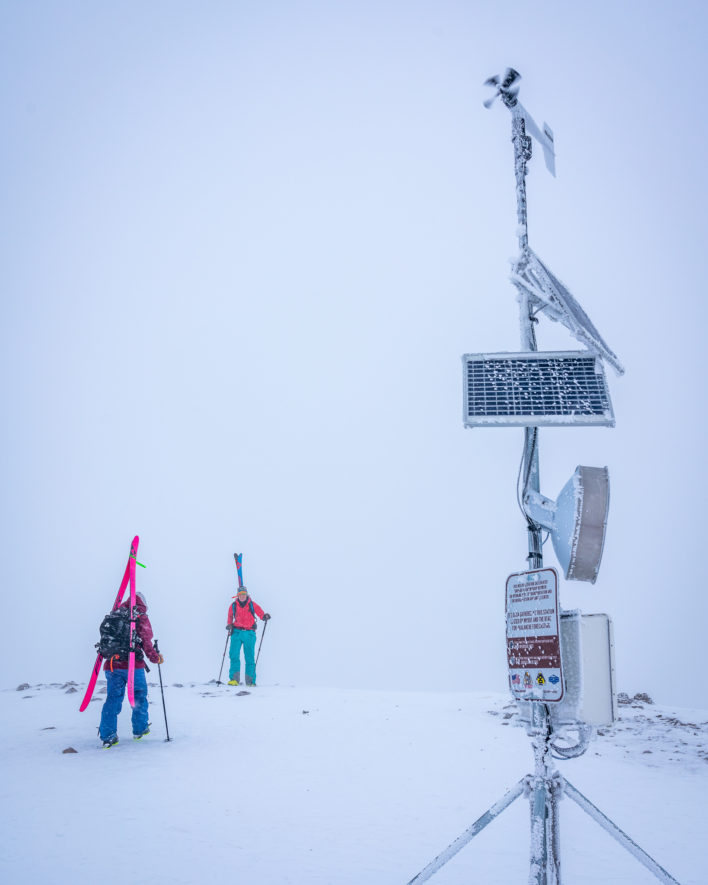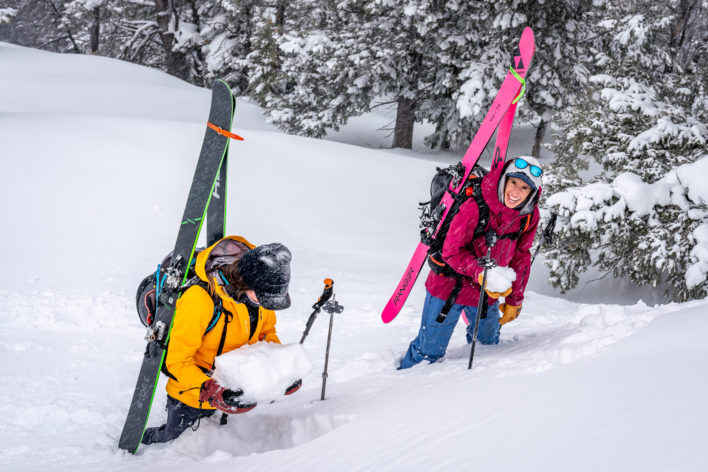
The cold Wyoming wind swirled wisps of snow across the couloir in Grand Teton National Park. I could see pockets of loading underneath the tall cliffs on the right and at the base of the rocks on the left wall. Opting to ski the seemingly unaffected center shot, I did my best to avoid the wind loaded spots. After 10 hop turns, the couloir dog legged and turned to the north where the wind was now blowing straight up the slope: the complete opposite direction of the day’s prevailing winds. I pulled into a safe zone to wait for my partners and was immediately blasted in the face with the reality that the wind is complicated and the current conditions weren’t at all what we had predicted. Only a few inches of snow had fallen in previous days, yet the small pockets could be potentially consequential in our steep terrain.
“How does anyone predict this and manage it?” I asked myself. After we safely skied out, our group discussed the wind in our debrief for the day. Did we get away with that line or had we made a good decision? While we had all learned about wind slabs in our avalanche classes, we didn’t feel like we had much to say for this complex situation. We had checked the weather stations throughout our region and looked at the wind speeds and directions over the past few days. We read the avalanche report and discussed the recent observations the night before and again in the morning and still we were surprised by what we found. I started jotting down questions about wind slab, as it turned out, I had a lot.

In any Level 1 avalanche course, we learn about the different types of avalanches. Each is its own beast and carries its own unique challenges. Some problems hide deep in the snowpack while others live on the surface. They can be prevalent across big regions or very specific to isolated locations. Yet with such finite time in Level 1 and 2 avalanche courses, it would be cumbersome to truly dive into the nuances of each. After experiencing wind slab so vividly, I wanted to learn how to bring my avalanche knowledge to each specific avalanche problem in hopes that I could more confidently answer that important debrief question: Were we lucky or were we good? I could continue along the standard educational track by enrolling in a Pro Level 1, the next course in the progression. However, the Pro 1 is an intense five day course designed for guides, patrollers and forecasters. As a professional big mountain skier, I do plan to eventually take the Pro 1, but it didn’t fit my needs and my specific questions at this time. I wondered if there was a way to continue learning about avalanches in a “curious life-long learning mountain explorer who happens to love skiing powder, exposed terrain, and steep couloirs” style path instead.
I decided to turn to the professionals at the American Avalanche Institute and pitched co-owner Sarah Carpenter on a custom course for myself and my frequent ski partners—Iain Kuo, Kit Deslauriers and Laura Gaylord—that dove deeper into each of these avalanche problems at a time in the season we expected to find them. We started with, you guessed it, wind slab. After online course work, two zoom sessions and one field day, we arrived at an answer to my question of how to predict and manage wind slab: it depends. And—as slightly infuriating as it might be—it turns out that “it depends” is the number one response to any questions one asks about avalanches.
To lay the foundation for the class, Sarah reminded us to always go back to the fundamentals of avalanche education before focusing on specific problems. Stay big picture, create a season history and consider what layers exist before trying to predict complex problems in consequential terrain. Never stop asking yourself, “Is there a recipe for an avalanche?”
Soon after, we zeroed in on wind slab. Sarah shared a paper “ OROGRAPHIC EFFECTS OF WIND AT STEVENS PASS SKI AREA ” by P. Morrison that felt like a beacon of scientific light reaffirming my experience. Over a four-year period, the study measured local wind speed and direction in specific locations at Stevens Pass Resort and compared them with the prevailing wind direction in that moment. Morrison found that terrain can greatly affect wind direction and speed to create unique flows that differ from the predominant wind direction. In the study, there were locations that consistently had the same wind direction “no matter the direction of the prevailing wind.”
“So how do you handle such variety?” I asked.
Sarah’s advice: Get to know the terrain you typically travel in and pay attention. There are usually common themes. You’ll see elevations and zones where it gets breezy on specific mountains. You can observe how a specific canyon funnels wind during a storm coming from a certain direction. In the Tetons, I feel like I have a better gauge for this and am often not surprised when I find protected snow in the lower east facing trees of a peak while the 10,000-foot ridge is getting hammered by our normal southwesterly winds.
Which brought me to the next question: “But then what about if I want to ski new terrain in new locations?”
New zones come with an inherent increase in uncertainty and, per Sarah, we must return to our avalanche fundamentals: With greater uncertainty, we must build in greater margins. This means taking time to slowly step out in new terrain, getting to know the area and even going back through weather observations to create your own season history. This is a classic example of an avalanche professional giving us an answer that requires diligence and patience instead of the mythical silver bullet answer that I was looking for,
After our classroom days, we ventured out to Teton Pass to hunt for wind slab in the wild. Lucky for us, but unlucky for the general snowpack, wind was a very relevant topic the week of our course because the Tetons had a ton of it! Local weather stations reported over 2,000 wind miles in four days, which is equivalent to sustained 25 mph and gusts above 75mph! I’d like to apologize and take full responsibility for the crazy amounts of wind. I promise next time, I’ll ask to do a course on super stable, amazing, open season, perfect snow.
Before heading out in the field we prepared our AM forecasting reports, by checking the weather stations and data on the Bridger Teton Avalanche Center website. We had conditions primed for wind slab. Light density, new snow (that was, ahem, available for transport), sustained 20-to-30 mile per hour winds, and an unprotected ridge. As we shared our forecasts, we found we all predicted touchy wind slabs in specific locations, giving us a considerable hazard for the day meaning small to large avalanches were likely.
Hiking up the ridge, we carved out hasty pits with our poles and found varying depths of wind slab. We looked at thin spots and hypothesized where we would be most likely to trigger the slab. However, the slabs were not as touchy as expected. Upon further investigation, we couldn’t even get the wind slabs on the little rollovers and convex features to move. Our shared hypothesis was incorrect. We were wrong! The wind slab seemed to have bonded well to the layer beneath and yet stayed soft enough to not propagate.

Sarah applauded us for having a hypothesis and reaffirmed the importance of having an opinion and testing it. Go out with a specific idea in mind. Put your hands in the snow. Dig little hasty pits to learn about surface problems. Use your poles and probe to feel layers deeper down in the snowpack. These methods are quick and easy ways to help you see if your hypothesis lines up. Often you will be wrong, and that is okay. Having an opinion and being wrong is part of learning.
We finished our day circling back to the big picture, focusing on our culture and approach to the backcountry rather than the snowpack. What does it look like to be a lifelong learner? And how would our decision-making change if we put our ski objectives on a yearly or even 5 year scale rather than day to day or weekly? Are there times when our uncertainty is lower? Do we have the patience to wait for them? These questions are equally if not more important than the wind speed or snow density. Avalanche courses help develop your toolkit, they do not give you a silver bullet to predicting avalanche problems. Instead, they teach you how to create a process so you can practice and sharpen these tools on every tour to continue growing your skills. The unknown of the mountains make them special and risk will always be part of the equation. It is okay to admit when you don’t know something, in fact, it’s a good sign!
In the end we learned a lot about wind slab, but it wasn’t necessarily in the way I would have predicted (fitting, huh?). Even with one of the top avalanche professionals in the country, we were not perfectly able to forecast the wind slab’s behavior during our field day. It was a humble reminder of the magic of snow and the mountains, that we cannot outsmart nature and it’s selection. Wind slabs are predictably unpredictable, and they deserve our respect.
Sophia Schwartz is a big mountain skier based out of Jackson Hole, Wyoming. When she’s not hunting for wind slabs, she can be found advocating for a better ski town community with Act Now JH.










Hi, Congrats, for the safe journey , yes ! you are right it is difficult to predict nature because nobody knows that what would happen in the next moment, in this kind of journeys your dress kit should be proper like Ski boots etc, and I am so glad to know that you completed your Adventure safely.